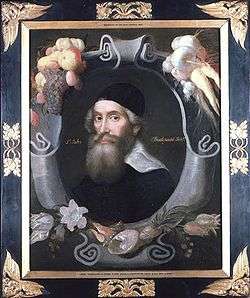John Tradescant the elder

John Tradescant the elder (pronunciation: /trəˈdɛskənt/; c. 1570s – 15–16 April 1638), father of John Tradescant the younger, was an English naturalist, gardener, collector and traveller, probably born in Suffolk, England. He began his career as head gardener to Robert Cecil, 1st Earl of Salisbury at Hatfield House, who initiated Tradescant in travelling by sending him to the Low Countries for fruit trees in 1610/11. He was kept on by Robert's son William, to produce gardens at the family's London house, Salisbury House. He then designed gardens on the site of St Augustine's Abbey for Edward Lord Wotton in 1615-23.
Later, Tradescant was gardener to the royal favourite George Villiers, 1st Duke of Buckingham, remodelling his gardens at New Hall, Essex and at Burley-on-the-Hill. John Tradescant travelled to the Nikolo-Korelsky Monastery in Arctic Russia in 1618 (his own account of the expedition survives in his collection), to the Levant and to Algiers during an expedition against the Barbary pirates in 1620, returned to the Low Countries on Buckingham's behalf in 1624, and finally went to Paris and (as an engineer for the ill-fated siege of La Rochelle) the Ile de Rhé with Buckingham. After Buckingham's assassination in 1628, he was then engaged in 1630 by the king to be Keeper of his Majesty's Gardens, Vines, and Silkworms at his queen's minor palace, Oatlands Palace in Surrey.

On all his trips he collected seeds and bulbs everywhere and assembled a collection of curiosities of natural history and ethnography which he housed in a large house, "The Ark," in Lambeth, London. The Ark was the prototypical "Cabinet of Curiosity" , a collection of rare and strange objects, that became the first museum open to the public in England, the Musaeum Tradescantianum. He also gathered specimens through American colonists, including his personal friend John Smith, who bequeathed Tradescant a quarter of his library. From their botanical garden in Lambeth, on the south bank of the Thames, he and his son, John, introduced many plants into English gardens that have become part of the modern gardener's repertory. A genus of flowering plants (Tradescantia) is named to honour him. Tradescant Road, off South Lambeth Road in Vauxhall, marks the former boundary of the Tradescant estate.
He was buried in the churchyard of St-Mary-at-Lambeth, as was his son; the churchyard is now established as the Museum of Garden History.
He is the subject of the novel Earthly Joys, by Philippa Gregory.
See also
- Edward Lhuyd - curator of Ashmolean museum
References
- Prudence Leith-Ross, The John Tradescants: Gardeners to the Rose and Lily Queen, 1984. ISBN 0-7206-0612-8.
- Arthur MacGregor (Editor), Tradescant's Rarities: Essays on the Foundation of the Ashmolean Museum, 1983. ISBN 0-19-813405-3.
- Mea Allan, The Tradescants. Their Plants, Gardens and Museum 1570-1662, London 1964.
- Jennifer Potter, Strange Blooms: The Curious Lives and Adventures of the John Tradescants, 2006. ISBN 1-84354-334-6
External links
- Tradescant Collection at the Ashmolean Museum
- Vauxhall Society
- Botany
- A Chilham garden designed by him